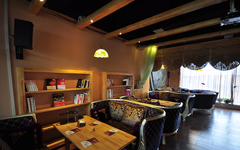Novice coffee shop location rules, what is the future of opening a coffee shop?
Follow the caf é (Wechat official account vdailycom) and found that Beautiful Cafe opened a small shop of its own.
To run a coffee shop, you can consider the first-class business area with convenient transportation to increase the occupancy rate. If you are working in a personalized, narrow market, consider operating in a secondary business area to reduce rents and other costs. When there are more than five chain stores around, you also do, then you must make characteristics, take the differentiation route, and good brand awareness, otherwise it is difficult to win.
If your shop is on a high street, you can't take the shops at both ends of the street. Because the customer will shop around, he may be tired, hungry or temporarily busy, and he is less likely to return to your store. The yin and yang side of the bunk is also very important. In the north, customers like to walk on the sunny side of the street, but there is less passenger flow on the shady side. For businesses, the same rent, on both sides of the road, the turnover is twice the difference. Try to open a shop in or near the most crowded place. Because a step away from the location of the store will lead to a 30% difference in sales. This has something to do with the flow of people, customers may come to this corner, then this aspect that customers can not reach. When choosing a site, consider whether the passenger flow route will be stopped by competitors.
Principles for the location of coffee shops: one of the details of the location on the way to the hustle and bustle: which kind of busy area to go to, and whether the preferred crowd is your target population. The first choice is on the way to the hustle and bustle, where the rent is cheaper and the number of passengers is not less than that of the busy place. Location selection should not only consider the location but not the competitive environment location. If there are several stores around, then you make a coffee chain, so that you can drive the flow of customers to each other, which is very beneficial.
Investors should pay more attention to choosing a good shop before opening a coffee shop, and they need repeated on-the-spot visits before opening a shop, and choosing a good location can reduce the investment risk. The above tips for choosing the location of coffee chains require investors to learn from them. These are the principles that should be paid attention to when choosing the location of a coffee chain. When opening a store, but also combined with the location of their own coffee chain store environment, to find a suitable development of the store, this is the first step to successful management.

Related readings:
Nine aspects to identify the good and bad of coffee beans
First, the trap of 100% pure coffee. This is the most obvious hint, because "100% pure coffee" does not indicate quality, but only means the use of high-profit, better anti-parasite Robusta coffee beans of low quality. This kind of coffee tastes more bitter. The shelf life is much more important than the "baking" time. Don't just think about judging the freshness of coffee by the date of baking, regardless of the expiration date must be an unwise choice.
Second, a wide variety of tastes is not a good thing. If a brand produces a variety of flavors of handmade coffee, they must not pay attention to the quality of coffee beans. This is not to say that a professional baker can't make two or three flavors (Klatch is a good example), but when you have a lot of choices, your chances of finding a good cup of coffee are greatly reduced. Over-reliance on blended coffee. A common cost-cutting technique is to buy low-grade coffee beans and mix them. If a company sells 10 kinds of coffee, eight of which are blended coffee, they must not be trusted.
Third, pay attention to the baking level. Most professional coffee roasters don't use words like bright, medium, or dark to describe roasting grades. They describe them as exaggerated synaesthesia, such as earthy or chocolate-colored coffee beans. If you don't see a word for flavor, it's likely that the coffee bean baker is unprofessional. This is by no means a good sign.
Fourth, pay attention to whether it is cupped or canned. Dehydrated coffee is usually bottled in glass, but it may also be packed in cans and plastics. None of this is environmentally friendly: more carbon dioxide is produced in both production and transportation. There is also a problem with transparent bags, because light is the main natural enemy of coffee beans, and darkness is their old friend.
Fifth, there is too much coffee in stock, which is worth thinking about. Unless you are buying coffee for the army or office, buy less than 2 pounds at a time. Because it deteriorates over time, and the most famous bakers don't want their products to stay on the shelf for a few weeks.
Sixth, the popular term for coffee. Natural, pure and eco-friendly sounds great, but it doesn't carry much weight. Look for USDA organic certification or Fair Trade certification stickers-many good coffees don't have these certifications, but beware of the traps behind the fancy words. The really useful information is the altitude of growth, the description of processing and the type of variety.
Seventh, whole bean coffee is not sold. If a brand does not sell whole bean coffee, it is not a good sign.
Eighth, coffee is sold in boxes. If it is not properly packaged, it is likely to be of poor quality, as it shows that the coffee does not pay attention to quality assurance and freshness, and the coffee will deteriorate quickly when exposed to light and air.
Ninth, there is a lack of local characteristics. Countries like Colombia and Guatemala are not small. They have many kinds of coffee. Listing farms and regions can stimulate purchasing confidence, and vice versa.
The quality of a cup of coffee is affected by the quality of coffee beans, so if you want a strong and good coffee, you can't choose bad coffee beans, that is to say, the step of choosing coffee beans should not be taken lightly. The above nine aspects allow you to easily select good coffee beans, plus the correct grinding, brewing method, a good cup of coffee will come out!
Important Notice :
前街咖啡 FrontStreet Coffee has moved to new addredd:
FrontStreet Coffee Address: 315,Donghua East Road,GuangZhou
Tel:020 38364473
- Prev

How much does it cost to open a cafe? Remember to examine it carefully.
As coffee is getting more and more attention from the public and the investment market is getting more and more attention, there are coffee shops around us, so how much does it cost to open a coffee shop? What are the projects that suit you? These are all problems that entrepreneurs should actively face. When you open a coffee shop for the first time, you must carefully examine how to choose a project. After reading the following analysis, you can understand
- Next

"performance Cafe" can be called a medium-sized business miracle.
In Guangzhou, the performance Cafe can be called a medium-sized business miracle. As of August this year, it has been on Zhongshan Road for eight years, while many coffee shops have closed down one after another. Miss long, the owner of the coffee shop, opened a coffee shop in order to dilute the cost for art exhibitions, but the latter became the main business, with exhibitions as a foil, and the coffee business was particularly prosperous.
Related
- What documents do you need to go through to open a coffee shop? coffee shop coffee shop certificate processing process
- How to purchase Coffee beans in small Cafe how to choose a suitable supplier for domestic Coffee supply Company
- How to drink Starbucks Fragrance White Coffee? how to make Australian White Coffee? what Italian coffee beans are recommended?
- The Story of Flora Coffee: the name of Flora Coffee Bean and the implication of the Flowers on Florna Coffee
- How much does a cup of coffee cost? How much is the profit of a cup of coffee? What is the profit of the coffee shop in a year?
- Yunnan small Coffee, known as "fragrant Coffee", introduces the characteristics of Alpine Arabica Coffee producing areas in Yunnan, China
- 2023 latest Starbucks full menu price list how much is a cup of Starbucks coffee what is better to drink the most popular hot and cold drinks recommended
- Starbucks different kinds of Coffee Price list Starbucks menu 2023 Top Ten Best drinks in Starbucks
- Starbucks Spring praise Comprehensive matching Coffee Bean theme Story Packaging implication and taste description
- The cost of a cup of coffee latte American coffee cost price and selling price

